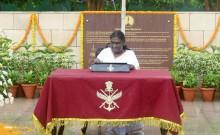Indian Space Research Organisation (ISRO) on Wednesday successfully launched the fifth satellite of the Indian Regional Navigation Satellite System (IRNSS) on board PSLV C31 rocket from the Satish Dhawan Space Centre in Sriharikota, Andhra Pradesh.
The 44.4-metre high Polar Satellite Launch Vehicle (PSLV) rocket, weighing 320 tonnes, blasted off at 9:31 am, IANS reported.
The Mission Control Facility (MCF) at Hassan in Karnataka thereupon took control of the satellite. The facility will "manage the satellite's orbit and fire the on-board motors till it is placed in its slotted orbit".
The fifth satellite -- IRNSS-1E with lift-off mass of 1425 kg -- is one of the seven satellites that will form the Space Segment -- a regional satellite navigation system similar to that of the United States' Global Positioning System (GPS). Unlike GPS, India's system is regional.
ISRO launched IRNSS-1A, 1B, 1C and 1D in July 2013, April 2014, October 2014 and March 2015 respectively. The fifth satellite carries "two types of payloads – navigation payload and ranging payload" and "also carries Corner Cube Retro Reflectors for laser ranging", according to ISRO.
"The navigation payload of IRNSS-1E will transmit navigation service signals to the users. This payload will be operating in L5-band and S-band. A highly accurate Rubidium atomic clock is part of the navigation payload of the satellite. The ranging payload of IRNSS-1E consists of a C-band transponder which facilitates accurate determination of the range of the satellite," the space agency explained.
ISRO will launch two more satellites to complete the "Space Segment". Out of the seven satellites, three have been positioned in geostationary orbit, while the other four will function from "inclined geosynchronous orbit."
Once all the satellites are positioned in their orbits, the Space Segment will send the location and time information to a chain of 'Ground Segments' located at 21 different locations in India. The ISRO Navigation Centre in Karnataka's Byalalu area will operate as the head of all other stations.
IRNSS is limited in area, but is similar to US' GPS techniques that provide location and time details accurately to everyone around the world, in any climatic condition; be it stormy or rainy. Unlike IRNSS' navigation system, GPS is capable of tracking information not only on Earth but near the planet as well.
IRNSS was designed to provide accurate location and timing to the Standard Positioning Service (SPS) users in India, using the SPS within the geographical boundary of India and a little beyond that.
Countdown to PSLV C31/IRNSS 1E Launch is progressing normally. 12 min to launch. Watch live: https://t.co/4xfAAd5IAs pic.twitter.com/hnzLyvMOpK
— ISRO (@isro) January 20, 2016















